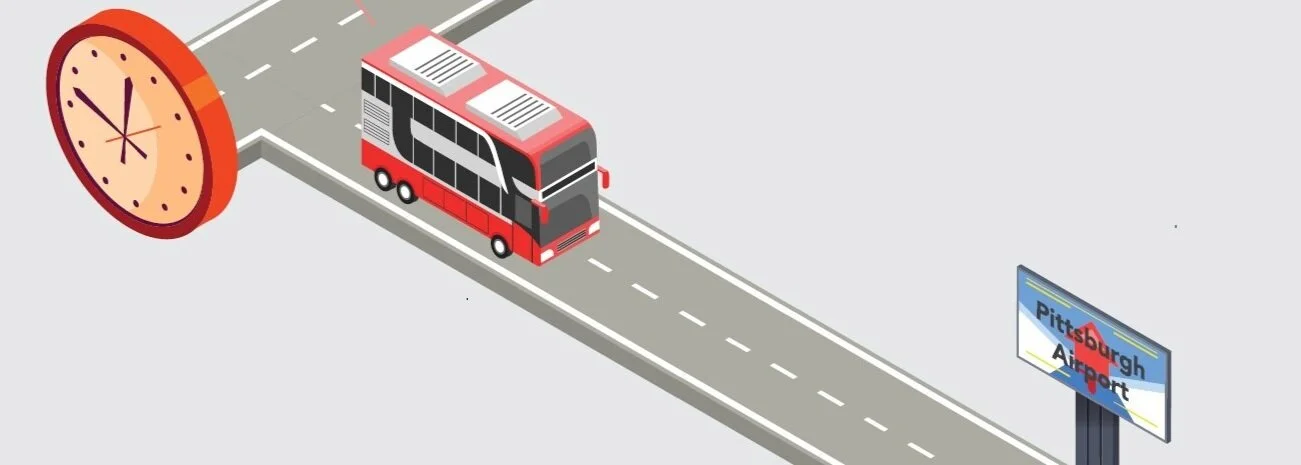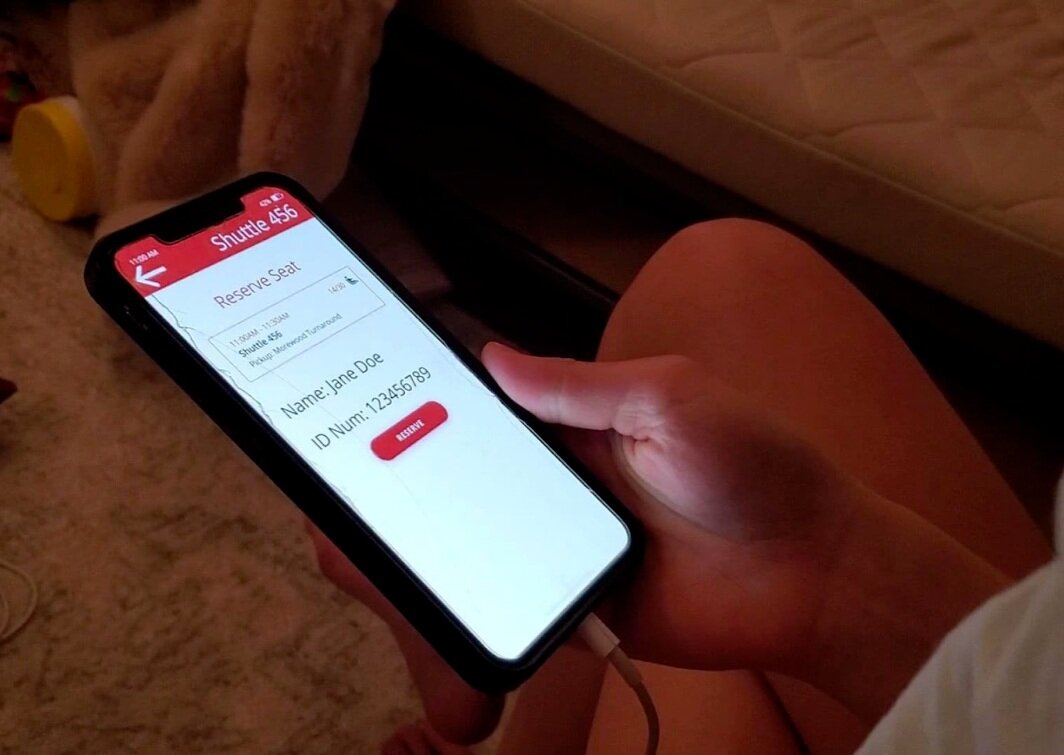
2019 User Centered Research Evaluation Final Team Project
CMU Airport Shuttle
The Shuttle Service in Carnegie Mellon University provides free transportation from campus to the student’s neighborhood. However, statistics have shown that shuttle users are decreasing every year. Our team conducted research to find why and develop new methods to improve the user experience.
Skills:
Flow Model, Walk the Wall, Reverse Brainstorming, Stakeholder Map, Survey Analysis, Contextual Inquiry, Semi-Structured Interview, Affinity Diagram, Storyboard, Speed Dating, 5-Second Test, Experience Prototyping
Team:
Dean Dijour / Alia Friedman / John Han / Bruce Liu / Kat Phelps
Current Statistics
From 2015 to 2018, there were approximately 40,000 less people using the CMU shuttle service. In order to find out why, our team interviewed the people involved in the shuttle system and the users.
Flow Model
From our interviews, we made a flow model that represents the webflow of the organizations involved in the shuttle service. We detected some pain points that students use more Uber & Lyft than the shuttle due to its lack of destinations it can travel despite its free charge.
Walk the Wall/Reverse Brainstorming
To further examine the pain points, we walked through the wall of individual data to find common features. Then we used wrote down our assumptions for each wall and then questioned each others and our own assumption in order to implement reverse brainstorming method.
Users primarily use the shuttle to go home from school for free.
What if the shuttle provided more destinations than ‘home’?
A majority of the challenged assumptions revolved around why people choose to use CMU transportation service in the first place. We thought of what other locations the users would want without financial burdens which gives more value than Uber or Lyft.
How about an airport?
With a great portion of the campus comprised of diverse out of state, and even out-of-country students, the airport is a central node for transportation to and from CMU.
Stakeholder Map
We first listed all the possible stakeholders regarding the journey to the airport, labeling them with symbols and the speech bubbles. After some drafts, we designed our final stakeholder map.
Main Stakeholders - CMU Students
Regularly travel in and out of Pittsburgh
Currently use various means of transportation to and from the airport when/if they go
Prefer multiple people in a ride for safety purposes
Contextual Inquiry/Affinity Diagram
To learn more about the current state of airport transportation, we interviewed four students who were from outside of Pittsburgh. From the interview, we formed interpretation notes to create an affinity diagram.
“I heard many friends using the bus and not getting to the airport on time”
“I will always pick the bus if I have the time since it is cheapest”
Participants preferred public bus over Uber/Lyft because it is cheaper. However, they prefer Uber/Lyft over bus because it is quicker to arrive and the journey is more comfortable/reliable. With this in mind, we realized there is a huge opportunity in utilizing the current CMU shuttle service where it can possibly catch both birds in one stone.
Survey
To further generalize our findings, we distributed our survey attempted to answer our research questions about methods of transportation, as well as behaviors, of Carnegie Mellon students when going to the airport.
Quantitative
All surveyed students have visited the airport this semester at least once, indicating that the airport is instrumental in student’s travel plans.
Rideshare was overwhelmingly the most popular method of getting to the airport, with the 28X behind by approximately 40%. We realized majority are willing to give up price for efficiency.
The risk of arriving late and missing one’s flight is much higher than the perceived cost of paying for rideshare trips.
Qualitative
Ideal form of transportation
Reasons for choosing their transportation options
Based on the word cloud generated from student’s responses students are looking for efficient, convenient, and reliable transportation options - implying a time urgency.
“CMU should probably offer this service during high volume travel times i.e. holidays, carnival, etc.”
55.6% of surveyed students believe CMU has a role to play in getting students to the airport, with the most popular idea being some sort of rideshare system which the university would pay for, most likely funded by the student transportation fee.
Solution
From walking the wall with our data, we decided to design a system that is low cost, fast, safe, reliable and trackable. Specifically, we aim to design a free CMU airport shuttle system that only takes CMU affiliates to the airport with no stops in between, along with an trackable mobile app of the service.
Storyboard/Speed dating
Before we dived further into the mobile app design, we designed some other possible solutions through storyboards. We then asked how the users perceived each storyboards through speed dating.
Through multiple speed dating, users in the end all favored the CMU airport shuttle system with a trackable mobile app that can also check its seat availability.
Bill’s flight leaves in 3 hours but he is worried because the journey takes too long due to the multiple stops. He’s also skeptical that the bus won’t come to the stop on time.
Thankfully, he can take the CMU Airport Shuttle which directly brings him to the airport. He opens up the app to check the schedule and the seat availability.
Bill gets to the airport almost 2 hours earlier than the departure time. He passes the gate without any time burden, As the flight takes off he relaxes comfortably.
Lo-Fi Wireframe
We wanted our screens to be as close to real case as possible, so that users feel more comfortable evaluating the system and less confused.
5-Second Testing
In our usability testing, users interacted with each screen for only 5 seconds. We wanted to receive near-instant feedback on our lo-fi prototype to gauge the interest and feasibility of our proposed solution to the airport transportation issue.
Students seem to be unfamiliar with a bus reservation system confusing it with reservation for the plane. Additionally, we observed potential users seemed to be confused about our reservation model mainly because the existing public transportation do not have reservation function.
Mid-Fi Wireframe
Overall, we changed the prototype to be much clearer with better readability. For example, we changed the wording of “reserve seat” to clearly indicate it was for airport shuttle and not for the airplane itself.
Experience Prototyping
To receive critical feedback based on a realistic scenario, we put five CMU students through the three scenarios outlined and had them carry out each task without interfering.
You have an hour to get to the airport. Using any transportation solution available to you, regardless of cost, demonstrate how you would get their from your current location.The time is now 10:30 AM. You need to get to the airport by 12 pm. Show us how you would get a seat on a shuttle that takes you to the airport by then.You need to walk to the airport shuttle bus stop by 1 pm from your apartment. Where do you go, and how do you get there?
For task 1, we noticed that users immediately turned on Uber but showed an expression of disgust when they saw the price. However, when completing task 2 and 3 with our app, users was rather delighted.
Overall our app was successful in terms of having a usable interface, as none of them had a hard time completing the task. After compiling our insights we've decided to change the app by giving clearer distinctions, better informational hierarchies, and more features.
Hi-Fi Wireframe
For our final prototype, we added extra features for convenience.
Login page
Text confirmation alerts
Bag selector - allow to reserve space for up to 3 bags
Reflection
Through our user centered research evaluation, we designed a dedicated airport shuttle and companion application, exclusively for CMU students, which is fast, reliable, and spacious that allows students to have a quick and comfortable ride.
Our team pitched our idea with the poster to end this project with a successful conclusion. This experience made me realize the value of a team and gave me the knowledge on how the procedure of UX research takes.






























